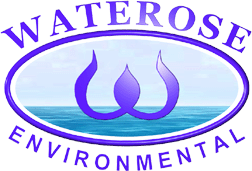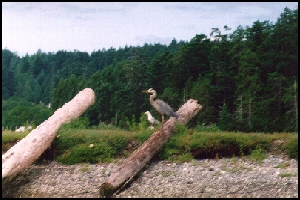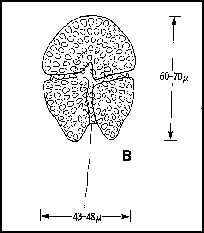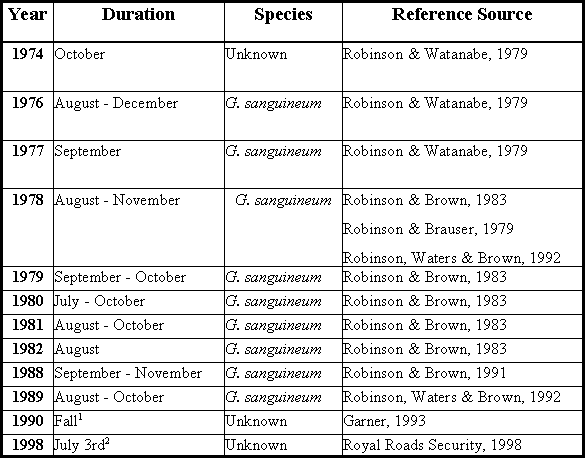 | ||||||
| Articles | Projects | Resume | Cartoons | Windsurfing | Paintings | Album |
Esquimalt Lagoon
State of the Ecosystem Report

Water Quality Analysis Project 1998
Waterose et. al.

Section 5. Red Tides and Fish Kill:
The Recurring Red Tide Phenomenon in Esquimalt Lagoon
Background of Red Tides
Literature Review of Red Tides in Esquimalt Lagoon
The Red Tide Phytoplankton Gymnodinium sanguineum
Sources, Triggers, and the Life Cycle of Gymnodinium sanguineum
Red Tide Occurrence in Esquimalt Lagoon
Fish Kill Events
The Recurring Red Tide Phenomenon in Esquimalt Lagoon:
Esquimalt Lagoon is a natural laboratory to study the phenomena of the recurring red tide event.
Background of Red Tides:
The study of red tides is significant because they are linked to paralytic shellfish poisoning, massive kills of fish and invertebrate populations, and luminescent water (Robinson and Watanabe, 1979). Red tides are characterized by a red discoloration of the water which is attributed to the high populations of photosynthetic Zooflagellates. Red tides have been associated with a variety of species which include: Gymnodinium breve off Florida; Gonyaulax tamarensis and Gonyaulax excavata off New England; Gymnodniium nelsoni (same as Gymnodinium sanguineum Hirasaka) off Japan, New Zealand, Chesapeake Bay, and Oslofjord; Gymnodinium splendens off Washington and California; Gonyaulax catenella and Gonyaulax acatenella off the coast of British Columbia; and, Gymnodinium sanguineum in Esquimalt Lagoon.
Literature Review of Red Tides in Esquimalt Lagoon:
The study of Red Tides and Gymnodinium sanguineum in Esquimalt Lagoon has been very intense and efforts have been focused on determining the potential sources, causes, triggers, and linkages of algae blooms. The following is a brief synopsis of the studies that have been completed. This list is by no means exhaustive and there are information gaps for some periods of time where there is no documented record.
- “Red Tide in Esquimalt Lagoon Due to Gymnodinium sanguineum Hirasaka.”
Robinson, M.G. and Watanabe, L.N. 1979.
This study examines the linkages between the population and life cycle of G. sanguineum and the physical characteristics of the Lagoon waters including temperature, sunlight, salinity, nutrients, nitrates, phosphates, and, chlorophyll. The significance of this study is that it provides a comprehensive biophysical and biochemical baseline of data. - “The Ecology of Esquimalt Lagoon: Nutrient Inputs - The Role of Sewage.”
Robinson, M.G. and Watanabe, L.N. 1980.
This report examines the role of sewage as a potential source of nutrients and studies the levels of fecal coliforms, salinity, nitrates, ammonia, and phosphates in the Lagoon and feeder surface streams. This report discusses the potential sources of nutrient loading into the Lagoon. The significance of this study is the possible linkage between sewage, nutrients, and red tide blooms of Gymnodinium sanguineum. - “A Recurrent Red Tide in a British Columbia Coastal Lagoon.”
Robinson, M.G. and Brown, L.N. 1983.
This report examines the recurrent red tide phenomena in Esquimalt Lagoon during the eight year period from 1974 to 1982, with an intense focus of red tide development in 1978. This report discusses the possible sources and life cycle of the Gymnodinium sanguineum. The significance of this publication is that it identifies that further study is required about the potential sources and life cycle of the Gymnodinium sanguineum because the evidence regarding long range movement or over-wintering cystation of the species was inconclusive. This does not exclude the possible linkages to nutrient pulses as a possible trigger. - “Copper Complexation During a Bloom of Gymnodinium sanguineum Harasaka (Dinophyceae) Measured by ASV.”
Robinson, M.G. and Brown, L.N. 1990.
This report examines the relationship between the red tide bloom of Gymnodinium sanguineum and the complexation of copper. This publication also discusses the complexation of zinc and other metal-algae interactions. The significance of this study is to document the relationship between the soluble exudates of the Gymnodinium sanguineum and metal complexations which may aid in finding a mechanism to control toxic blooms. - “Phytoplankton of Esquimalt Lagoon, British Columbia: Comparison with West Vancouver Island Coastal and Offshore Waters.”
Robinson, M.G., Waters, R.E., and Brown, L.N. 1992.
This report examines the taxonomic classification and occurrence of phytoplankton in the Lagoon. The significance of this study is the identification of some unknown species of Gymnodinium and the clarification of the possible overlapping of species identification.
The Red Tide Phytoplankton Gymnodinium sanguineum:
The study of Gymnodinium sanguineum in Esquimalt Lagoon has been focused on determining the potential sources, causes, triggers, and life cycle of the Gymnodinium sanguineum. The red tides in Esquimalt Lagoon are characterized by an initial red discoloration of the water which increases in intensity and size over two months (Robinson & Watanabe, 1979). The color resembles blood or tea and an odor, like molasses, accompanies the event. The duration of the blooms average two months and are followed by a greenish-white tide with a characteristic sulfide odor. The white tide phase is usually brief, and lasts only a few days.The Gymnodinium sanguineum is an autotrophic phytoplankton which is flagellated and photo-sensitive (Robinson and Watanabe, 1979). The graphic below in Figure 4 is reproduced from Robinson and Watanabe, 1979.

It moves up and down in the water column by means of phototaxis. During sunlight hours, it occupies the upper water column and produces oxygen by photosynthesis. During lightless hours, it occupies the lower water column, and consumes oxygen. When the colony reaches maximum capacity or “blooms”, it dies and the thick mats of algae colonies sink to the bottom of the shallow Lagoon. The algae bloom is decomposed by oxygen consuming bacteria.
Sources, Triggers, and the Life Cycle of Gymnodinium sanguineum:
The are several possibilities to explain the seeding of the recurrent red tide phenomena. These include: the presence of an endogenous vegetative state population; the presence of an endogenous dormant state population; and, the introduction of an exogenous population (Robinson and Brown, 1983).There is no evidence to support the supposition of an endogenous vegetative population that survives in the water column throughout the entire year (Robinson and Brown, 1983).
There is evidence of hypnocysts collected from the sediments in the Lagoon. However, it is inconclusive as to whether these are Gymnodinium sanguineum. Attempts to both induce and exduce the hypnocyst state of the Gymnodinium sanguineum in the laboratory by the application of physical and chemical stressors have been unsuccessful (Robinson and Brown, 1983).
The third speculation is that the Gymnodinium sanguineum are regularly transported from the coast of California by the upwelling of the California Undercurrent water annually during June to November off the entrance to the Juan de Fuca Strait (Robinson and Brown, 1983). This postulation is supported by the simultaneous occurrence of Gymnodinium sanguineum in Esquimalt Lagoon and Friday Harbor in 1982, both of which adjoin the Strait.
To date, there is no clear cause and effect relationship between the initiation of the Gymnodinium sanguineum blooms and: weather; temperature; nutrients; physical and chemical properties of the water; and, biological populations in the water column (Robinson and Brown, 1983). There is a direct relationship between the intensity of the blooms and the total rainfall which suggests a correlation to the amount of nutrient loading by pulse loading.
The phenomena of the white tide, which appears as a post red tide bloom, is associated with oxygen starvation due to the high cell densities and die off of the Gymnodinium sanguineum. It is not clear whether the depletion of oxygen and increased biological oxygen demand in the Lagoon can be linked with the demise of populations of other Lagoon organisms.
Red Tide Occurrence in Esquimalt Lagoon:
This is usually an annual event and occurs during the fall period. The documented events are summarized in Table 5.1. This list is by no means exhaustive, and there are information gaps where the documented incidence of red tide was not located.

Notes to Table 5.1:
- “Algae Bloom results in major fish kill in the Lagoon. Septic systems were deemed to be a ‘contributor’ to the problem but not necessarily the ‘cause’.[(Gazette - September 26, 1993)].
- The water of the Lagoon near the boat jetty, covering an area of 40-50 square meters was observed as ‘pink’. Water samples were obtained.
Fish Kill Events:
One of the primary concerns about the health of Esquimalt Lagoon is the incidence of “fish kills”, where massive numbers of resident fish die. It is estimated that up to two-thirds of the fish population die at one time during one of these events. The most recent one occurred on Monday, August 18, 1997 (Young, 1997). There has been much speculation regarding the cause of these events in Esquimalt Lagoon. The potential causes include: linkage to red tide events; algae growth; leaking septic fields; and, rollover.The event that occurred in 1997 was investigated by Federal Fisheries and Oceans supervisor, Larry Paike. He described this occurrence as a natural phenomena that the Esquimalt Lagoon is particularly vulnerable to due to its’ minimal flushing. The combined factors of an extended period of hot weather, no wind and low inflow from surface streams likely caused the water to stagnate. Subsequently, when the air turbulence increased, the wind flipped the lower layer of water in the Lagoon to the top, hence, the rollover. The lower layer of water does not contain enough dissolved oxygen, possibly due to lack of turbulence, to support the fish population that resides closer to the surface. Consequently, when the water rolled over and was thoroughly mixed, the total dissolved oxygen concentration dropped below levels that fish require for survival. The fish populations were unable to react or leave and consequently were asphyxiated.
There is a linkage between algae blooms and fish kill (Robinson, 1998). The algae growth consumes a significant portion of the available oxygen when it dies off. This is especially true with phytoplankton which move by phototaxis to the lower water column during periods of low incoming solar short wave energy. In other words, during the night time these algae sink to the bottom of the water column and consume oxygen through respiration. The algae growth peaks at the maximum growth threshold capacity and then the blooms die off and the masses sink to the bottom of the water column. The dead blooms are decomposed by bacteria and detritivores which consume the remaining oxygen at the bottom of the water column. This is how the bottom layer of the water becomes anoxic. Then, a roll over event can again cause the entire water column to be oxygen depleted.
If the algae blooms are in large pockets in the Lagoon, this creates large areas of anoxic water. This can cause localized kills of organisms requiring oxygen, including filter feeders, bivalves, fish, and crabs.
One of the most frequently asked questions about Red Tides and Fish Kill is: "Is it natural?". This is a difficult question to answer with the information that is available. It is natural in that the causative organisms exist in nature. Natural ecosystems have a threshold capacity to absorb change. The frequency and magnitude of the size of these events may be affected by anthropogenic inputs such as increased nutrients. A broader temporal scope of frequency and magnitude is required to determine if there is an increasing trend.
A dual research approach could provide additional information to answer this question. Firstly, the indigenous First Nations people may have folklore knowledge about previous red tides and fish kill events. Secondly, the compilation of recorded historic information, and measurement of ongoing events may provide enough information to calculate if a trend exists. The researcher must try to encapsulate the size and duration of the events to determine if a trend exists, and if so, how does it relate to anthropogenic activities around the Lagoon.
These events have a significant impact on both the intrinsic and the anthropogenic values of the Esquimalt Lagoon.
To Section 6. Hydrocarbons
Index:
- Introduction
- History and Land Use
- Geomorphology
- Nutrients and Coliforms
- Red Tides and Fish Kill
- Hydrocarbons
- Sample Procedure
- Analysis Procedure
- Results
- Discussion
- Future Study
- References
- Photo Album


 email Waterose
email Waterose
Please Sign My Guestbook
Please View My Guestbook

| Articles | Projects | Resume | Cartoons | Windsurfing | Paintings | Album |
 | ||||||